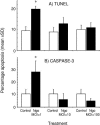Infection of human fallopian tube epithelial cells with Neisseria gonorrhoeae protects cells from tumor necrosis factor alpha-induced apoptosis
- PMID: 16714596
- PMCID: PMC1479248
- DOI: 10.1128/IAI.00012-06
Infection of human fallopian tube epithelial cells with Neisseria gonorrhoeae protects cells from tumor necrosis factor alpha-induced apoptosis
Abstract
Following infection with Neisseria gonorrhoeae, bacteria may ascend into the Fallopian tubes (FT) and induce salpingitis, a major cause of infertility. In the FT, interactions between mucosal epithelial cells and gonococci are pivotal events in the pathogen's infection cycle and the inflammatory response. In the current study, primary FT epithelial cells were infected in vitro with different multiplicities of infection (MOI) of Pil+ Opa+ gonococci. Bacteria showed a dose-dependent association with cells and induced the secretion of tumor necrosis factor alpha (TNF-alpha). A significant finding was that gonococcal infection (MOI = 1) induced apoptosis in approximately 30% of cells, whereas increasing numbers of bacteria (MOI = 10 to 100) did not induce apoptosis. Apoptosis was observed in only 11% of cells with associated bacteria, whereas >84% of cells with no adherent bacteria were apoptotic. TNF-alpha was a key contributor to apoptosis, since (i) culture supernatants from cells infected with gonococci (MOI = 1) induced apoptosis in naïve cultures, suggesting that a soluble factor was responsible; (ii) gonococcal infection-induced apoptosis was inhibited with anti-TNF-alpha antibodies; and (iii) the addition of exogenous TNF-alpha induced apoptosis, which was inhibited by the presence of increasing numbers of bacteria (MOI = 10 to 100). These data suggest that TNF-alpha-mediated apoptosis of FT epithelial cells is likely a primary host defense mechanism to prevent pathogen colonization. However, epithelial cell-associated gonococci have evolved a mechanism to protect the cells from undergoing TNF-alpha-mediated apoptosis, and this modulation of the host innate response may contribute to establishment of infection. Understanding the antiapoptotic mechanisms used by Neisseria gonorrhoeae will inform the pathogenesis of salpingitis and could suggest new intervention strategies for prevention and treatment of the disease.
Figures






Similar articles
-
Apoptosis related genes expressed in cultured Fallopian tube epithelial cells infected in vitro with Neisseria gonorrhoeae.Biol Res. 2007;40(3):319-27. Epub 2008 Apr 17. Biol Res. 2007. PMID: 18449459
-
Gonococcal infection of human fallopian tube mucosa in organ culture: relationship of mucosal tissue TNF-alpha concentration to sloughing of ciliated cells.Sex Transm Dis. 1999 Mar;26(3):160-5. doi: 10.1097/00007435-199903000-00007. Sex Transm Dis. 1999. PMID: 10100774
-
Local induction of tumor necrosis factor as a molecular mechanism of mucosal damage by gonococci.Microb Pathog. 1992 May;12(5):333-41. doi: 10.1016/0882-4010(92)90096-7. Microb Pathog. 1992. PMID: 1501572
-
Pathogenesis of Neisseria gonorrhoeae and the Host Defense in Ascending Infections of Human Fallopian Tube.Front Immunol. 2018 Nov 21;9:2710. doi: 10.3389/fimmu.2018.02710. eCollection 2018. Front Immunol. 2018. PMID: 30524442 Free PMC article. Review.
-
Mechanisms of mucosal invasion by pathogenic Neisseria.Rev Infect Dis. 1983 Sep-Oct;5 Suppl 4:S708-14. doi: 10.1093/clinids/5.supplement_4.s708. Rev Infect Dis. 1983. PMID: 6415784 Review.
Cited by
-
Burkholderia pseudomallei Differentially Regulates Host Innate Immune Response Genes for Intracellular Survival in Lung Epithelial Cells.PLoS Negl Trop Dis. 2016 Jul 1;10(7):e0004730. doi: 10.1371/journal.pntd.0004730. eCollection 2016 Jul. PLoS Negl Trop Dis. 2016. PMID: 27367858 Free PMC article.
-
Dynamics of Neisseria gonorrhoeae attachment: microcolony development, cortical plaque formation, and cytoprotection.Infect Immun. 2007 Oct;75(10):4743-53. doi: 10.1128/IAI.00687-07. Epub 2007 Aug 6. Infect Immun. 2007. PMID: 17682045 Free PMC article.
-
Is gonococcal disease preventable? The importance of understanding immunity and pathogenesis in vaccine development.Crit Rev Microbiol. 2016 Nov;42(6):928-41. doi: 10.3109/1040841X.2015.1105782. Epub 2016 Jan 23. Crit Rev Microbiol. 2016. PMID: 26805040 Free PMC article. Review.
-
Cellular heterogeneity of human fallopian tubes in normal and hydrosalpinx disease states identified using scRNA-seq.Dev Cell. 2022 Apr 11;57(7):914-929.e7. doi: 10.1016/j.devcel.2022.02.017. Epub 2022 Mar 22. Dev Cell. 2022. PMID: 35320732 Free PMC article.
-
Modified Profile of Matrix Metalloproteinase 2 and 9 Production by Human Fallopian Tube Epithelial Cells After Infection In Vitro With Neisseria gonorrhoeae.J Infect Dis. 2017 Feb 1;215(3):452-455. doi: 10.1093/infdis/jiw568. J Infect Dis. 2017. PMID: 27932616 Free PMC article.
References
-
- Ayala, P., J. Scott Wilbur, L. M. Wetzler, J. A. Tainer, A. Snyder, and M. So. 2005. The pilus and porin of Neisseria gonorrhoeae cooperatively induce Ca2+ transients in infected epithelial cells. Cell. Microbiol. 7:1736-1748. - PubMed
-
- Beck, S. C., and T. F. Meyer. 2000. IgA1 protease from Neisseria gonorrhoeae inhibits TNF alpha-mediated apoptosis of human monocytic cells. FEBS Lett. 472:287-292. - PubMed
-
- Binnicker, M. J., R. D. Williams, and M. A. Apicella. 2003. Infection of human urethral epithelium with Neisseria gonorrhoeae elicits an upregulation of host anti-apoptotic factors and protects cells from staurosporine-induced apoptosis. Cell. Microbiol. 5:549-560. - PubMed
-
- Brunham, R. C., B. Binns, F. Guijon, D. Danforth, M. L. Kosseim, F. Rand, J. Mcdowell, and E. Rayner. 1988. Etiology and outcome of acute pelvic inflammatory disease. J. Infect. Dis. 158:510-517. - PubMed
Publication types
MeSH terms
Substances
LinkOut - more resources
Full Text Sources
Other Literature Sources

